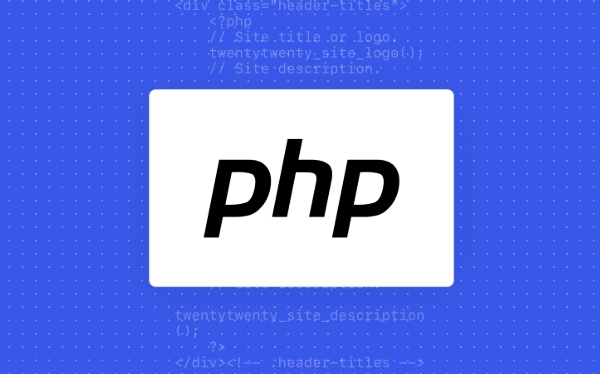It is recommended to use the DatePeriod class to traverse date ranges in PHP. 1. The DatePeriod class is introduced from PHP 5.3. Date traversal is implemented by setting the start date, end date and interval. For example, generate a date list from 2024-01-01 to 2024-01-05, which does not include the end date by default; 2. If you need to include the end date, you can adjust the end date or set the INCLUDE_END_DATE parameter; 3. The manual loop method can also complete the traversal using the DateTime object and the modify() method, which is suitable for scenarios where step size needs to be flexibly controlled; 4. Note that time zone issues should be explicitly set to avoid the system's default time zone affecting the results; 5. PHP automatically handles the difference in leap years and month days without additional processing. The two methods have their own advantages and disadvantages, just choose the appropriate method according to your needs.

Processing date ranges is actually quite common in PHP, such as generating calendars, stating reports, or scheduling tasks. If you want to know how to iterate over a date interval, using the built-in DatePeriod class is the most straightforward way.

Use DatePeriod to traverse date ranges
PHP has introduced the DatePeriod class since 5.3, which is specifically used to traverse a date or time range. The basic idea is to set the start date, end date and interval (such as daily and weekly), and then hand it over to DatePeriod for processing.

For example: If you want to go from 2024-01-01 to 2024-01-05, take one step every day, you can write it like this:
$startDate = new DateTime('2024-01-01');
$endDate = new DateTime('2024-01-05');
$interval = new DateInterval('P1D'); // Once a day $period = new DatePeriod($startDate, $interval, $endDate);
foreach ($period as $date) {
echo $date->format('Ym-d') . PHP_EOL;
} Note that the end date is not included by default . In other words, the above code is only output to 2024-01-04. If you want to include the last day, you can add $endDate one day later, or set the third parameter to DatePeriod::EXCLUDE_START_DATE or DatePeriod::INCLUDE_END_DATE to control behavior.

Manual loops can be done
If you don't want to use DatePeriod , you can also write a loop yourself and add or subtract the time step by step using the DateTime object. Although the code is more complex, the logic is more intuitive.
for example:
$startDate = new DateTime('2024-01-01');
$endDate = new DateTime('2024-01-05');
while ($startDate <= $endDate) {
echo $startDate->format('Ym-d') . PHP_EOL;
$startDate->modify(' 1 day');
}The advantage of this method is that you can control step size more flexibly, such as not skipping certain situations every day. The disadvantage is that it is a little bit more verbose, and it is easy to cause a dead cycle due to errors in boundary judgment.
Frequently Asked Questions and Notes
Time zone problem : If you do not specify a time zone, the server's system time zone will be used by default. It is recommended to set explicitly, such as:
$timezone = new DateTimeZone('Asia/Shanghai'); $startDate = new DateTime('2024-01-01', $timezone);
Format output : When using
format()method, remember not to write the parameters incorrectly. Commonly used ones include'Ym-d','d/m/Y', etc.Be careful when ending conditions : especially when you use
modify()oradd(), don't make it into an infinite loop.You don’t have to worry about the length of the leap year/month : PHP has helped you handle the details of the days and leap year in each month, so you can add and subtract it with confidence.
Basically that's it. Using DatePeriod is the most recommended way, it is simple and not easy to make mistakes. The manual approach is suitable for situations where you need more granular control. Both methods are good, depending on how you use them.
The above is the detailed content of php iterate over a date range. For more information, please follow other related articles on the PHP Chinese website!

Hot AI Tools

Undress AI Tool
Undress images for free

Undresser.AI Undress
AI-powered app for creating realistic nude photos

AI Clothes Remover
Online AI tool for removing clothes from photos.

Clothoff.io
AI clothes remover

Video Face Swap
Swap faces in any video effortlessly with our completely free AI face swap tool!

Hot Article

Hot Tools

Notepad++7.3.1
Easy-to-use and free code editor

SublimeText3 Chinese version
Chinese version, very easy to use

Zend Studio 13.0.1
Powerful PHP integrated development environment

Dreamweaver CS6
Visual web development tools

SublimeText3 Mac version
God-level code editing software (SublimeText3)

Hot Topics
 php regex for password strength
Jul 03, 2025 am 10:33 AM
php regex for password strength
Jul 03, 2025 am 10:33 AM
To determine the strength of the password, it is necessary to combine regular and logical processing. The basic requirements include: 1. The length is no less than 8 digits; 2. At least containing lowercase letters, uppercase letters, and numbers; 3. Special character restrictions can be added; in terms of advanced aspects, continuous duplication of characters and incremental/decreasing sequences need to be avoided, which requires PHP function detection; at the same time, blacklists should be introduced to filter common weak passwords such as password and 123456; finally it is recommended to combine the zxcvbn library to improve the evaluation accuracy.
 PHP Variable Scope Explained
Jul 17, 2025 am 04:16 AM
PHP Variable Scope Explained
Jul 17, 2025 am 04:16 AM
Common problems and solutions for PHP variable scope include: 1. The global variable cannot be accessed within the function, and it needs to be passed in using the global keyword or parameter; 2. The static variable is declared with static, and it is only initialized once and the value is maintained between multiple calls; 3. Hyperglobal variables such as $_GET and $_POST can be used directly in any scope, but you need to pay attention to safe filtering; 4. Anonymous functions need to introduce parent scope variables through the use keyword, and when modifying external variables, you need to pass a reference. Mastering these rules can help avoid errors and improve code stability.
 How to handle File Uploads securely in PHP?
Jul 08, 2025 am 02:37 AM
How to handle File Uploads securely in PHP?
Jul 08, 2025 am 02:37 AM
To safely handle PHP file uploads, you need to verify the source and type, control the file name and path, set server restrictions, and process media files twice. 1. Verify the upload source to prevent CSRF through token and detect the real MIME type through finfo_file using whitelist control; 2. Rename the file to a random string and determine the extension to store it in a non-Web directory according to the detection type; 3. PHP configuration limits the upload size and temporary directory Nginx/Apache prohibits access to the upload directory; 4. The GD library resaves the pictures to clear potential malicious data.
 Commenting Out Code in PHP
Jul 18, 2025 am 04:57 AM
Commenting Out Code in PHP
Jul 18, 2025 am 04:57 AM
There are three common methods for PHP comment code: 1. Use // or # to block one line of code, and it is recommended to use //; 2. Use /.../ to wrap code blocks with multiple lines, which cannot be nested but can be crossed; 3. Combination skills comments such as using /if(){}/ to control logic blocks, or to improve efficiency with editor shortcut keys, you should pay attention to closing symbols and avoid nesting when using them.
 How Do Generators Work in PHP?
Jul 11, 2025 am 03:12 AM
How Do Generators Work in PHP?
Jul 11, 2025 am 03:12 AM
AgeneratorinPHPisamemory-efficientwaytoiterateoverlargedatasetsbyyieldingvaluesoneatatimeinsteadofreturningthemallatonce.1.Generatorsusetheyieldkeywordtoproducevaluesondemand,reducingmemoryusage.2.Theyareusefulforhandlingbigloops,readinglargefiles,or
 Tips for Writing PHP Comments
Jul 18, 2025 am 04:51 AM
Tips for Writing PHP Comments
Jul 18, 2025 am 04:51 AM
The key to writing PHP comments is to clarify the purpose and specifications. Comments should explain "why" rather than "what was done", avoiding redundancy or too simplicity. 1. Use a unified format, such as docblock (/*/) for class and method descriptions to improve readability and tool compatibility; 2. Emphasize the reasons behind the logic, such as why JS jumps need to be output manually; 3. Add an overview description before complex code, describe the process in steps, and help understand the overall idea; 4. Use TODO and FIXME rationally to mark to-do items and problems to facilitate subsequent tracking and collaboration. Good annotations can reduce communication costs and improve code maintenance efficiency.
 Quick PHP Installation Tutorial
Jul 18, 2025 am 04:52 AM
Quick PHP Installation Tutorial
Jul 18, 2025 am 04:52 AM
ToinstallPHPquickly,useXAMPPonWindowsorHomebrewonmacOS.1.OnWindows,downloadandinstallXAMPP,selectcomponents,startApache,andplacefilesinhtdocs.2.Alternatively,manuallyinstallPHPfromphp.netandsetupaserverlikeApache.3.OnmacOS,installHomebrew,thenrun'bre
 Learning PHP: A Beginner's Guide
Jul 18, 2025 am 04:54 AM
Learning PHP: A Beginner's Guide
Jul 18, 2025 am 04:54 AM
TolearnPHPeffectively,startbysettingupalocalserverenvironmentusingtoolslikeXAMPPandacodeeditorlikeVSCode.1)InstallXAMPPforApache,MySQL,andPHP.2)Useacodeeditorforsyntaxsupport.3)TestyoursetupwithasimplePHPfile.Next,learnPHPbasicsincludingvariables,ech






